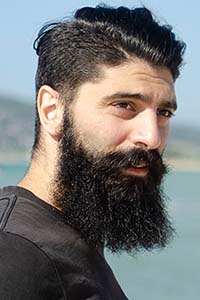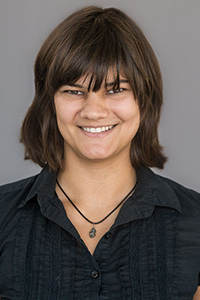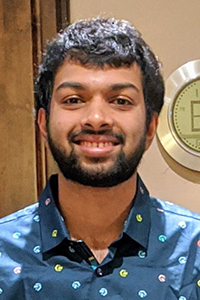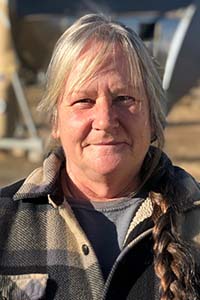The Allen Telescope Array has embarked on a survey of nearby stars


It’s 6 o’clock in the morning—sunrise is just warming the horizon—when Pranav Premnath, a research assistant at the Allen Telescope Array (ATA), shuffles to the desk. He boots up his computer, rubbing the sleep from his eyes as he waits. Last night, he calibrated the ATA, an array of small radio dishes designed to pick up signals from space, to observe Wolf 424, a binary system consisting of two red dwarf stars.
When Pranav connects to the ATA systems, he confirms the array’s antennas spent the last night focused on one patch of sky containing Wolf 424 at the desired radio frequency. Now it’s time to recalibrate the instrument at a new frequency band for the next round of observations.

“Odd hours are part of observing,” says Pranav. “My schedule depends on when a star is visible, and that’s just a matter of the time of year and Earth’s rotation.”
Pranav is leading a survey of 300 stellar objects that Dr. Sofia Sheikh, who recently joined the ATA team as an NSF-ASCEND Postdoctoral Fellow, identified from the Research Consortium on Nearby Stars (RECONS). Astronomers compiled this list of all stars within 10 parsecs, or about 30 lightyears, of Earth in 1994 and continue to update it as new discoveries are made.
Of course, the observation targets aren’t the stars themselves but the stellar systems, which include any planets orbiting the stars. Some of the stars in the RECONS list are known to host planets, but statistically all of them should have planetary systems and around 10-20 percent should have a planet that could be habitable.
Each target in Pranav’s survey is observed multiple times to capture the ATA’s entire bandwidth capabilities. One observation can include two tunings, each spanning 700 MHz of radio frequency, so it takes about 8 passes to listen across 1-12 GHz for any sign of advanced life.
WHAT MAKES THE ATA SPECIAL
The Search for Extraterrestrial Intelligence (SETI) has long focused on radio emission because it’s useful for communication and travels through interstellar space easily. In fact, humans use radio so much that an advanced civilization could easily eavesdrop on us if they tuned their radio receivers in our direction. Scientists figure there’s a decent chance other advanced civilizations are using radio as well, and this is why the ATA, one of the SETI Institute’s crowning achievements, consists of radio antennas.

Observatory in Hat Creek, CA. Image Credit: Simon Steel.
The ATA is located at Hat Creek Radio Observatory (HCRO), which is nestled between farmland in Lassen National Forest, about a 90-minute drive Northeast from Redding, California. The instrument, which is the only radio array built with the SETI as its primary purpose, consists of 42 six-meter dishes. Each dish has specialized hardware developed specifically to detect radio signals that could originate from advanced civilizations beyond Earth.
An array allows for more flexibility than a single large dish—like the Greenbank Telescope in West Virginia or the legendary Arecibo Telescope that was in Puerto Rico. This is because the antennas can all function together, separately, or a combination of the two.
“For this survey we’re using the ATA’s beam forming capability,” says Dr. Sheikh. “So, we’re pointing many antennas at the same patch of sky to increase the sensitivity of our observations. Because the ATA is comprised of 40ish small antennas rather than a single large dish, it’s extremely flexible. Beam forming is just one of many observing modes.”
When the antennas are pointed at the same patch of sky, they make more sensitive observations of targets within that field of view. This could be a single star or multiple if the objects are in the same patch of sky when viewed from the ATA.
The dishes can also be used separately to observe the huge swaths of the night sky—albeit at a lower sensitivity than when used together like in the previous scenario. In this mode, the ATA can observe an area 500 times larger than the moon at once.
And the dishes can be used in any combination. You could have a cluster of three dishes observing one patch of sky with two targets of interest and use the rest to observe a wider field of view and all the billions of stars in it. It depends on the team’s scientific goals.
GIVING THE ATA A FACELIFT

The ATA was built in the early 2000s with the first observations in 2007. Telescope hardware, particularly computing technology, has advanced significantly since then and the ATA needed an upgrade to reach its full potential. Thanks to generous support from Franklin Antonio, the onsite team has spent the last two years upgrading 20 of the array’s front-end receivers as well as the legacy signal processing hardware.
This hard work means the ATA is more sensitive and reliable—capable of observing even fainter signals than ever before. The new digital backend can process 20x the bandwidth compared to the original setup, observe many more stars simultaneously, and search for more complex signals. The ATA can observe from 1-12 GHz continuously, which is different from other instruments.
The team is making good use of these upgrades in the survey of nearby stars.
REDUCING INTERFERENCE
Interference is a serious concern for radio SETI instruments like the ATA. The instrument’s frequency coverage excludes most interference from the universe as well as molecules in our own atmosphere, but a rogue microwave or Bluetooth device could cause a spike that’s easily confused as a sign of E.T.
To combat this, the ATA team regularly monitors for potential sources of radio interference, and during recent maintenance, saw an alarming spike in interference from one of the dishes while pointed in a specific direction. Dr. Sheikh, who was observing remotely, spoke to the onsite team about what she was seeing, and luckily it only took a quick walk outside to find the culprit.
A tree had grown too close to the dish. Since trees are warm bodies, the same temperature as the Earth, it was creating the interference the team saw in their observations. The tree was removed, and observations could continue. It also gave the team a good laugh.
AUTOMATING SETI
While Pranav had to get up early this morning, he’s hoping that will soon be a thing of the past.
“Every time we finish an observation, we have to make sure the instrument is calibrated correctly,” says Pranav. “This could mean making sure the ATA is pointed at the right target or making sure it’s tuned to the new frequency. We’ve started automating this process, but we don’t trust it enough yet to let it run by itself.”
To automate the ATA’s observations, Pranav and his advisor Dr. Wael Farah, a Postdoctoral Researcher at the ATA, are continuously developing and deploying automation procedures to leverage the capability of the instrument.
“Everything is so new,” says Wael. “So we have to watch it closely to make sure everything is on track. Once we trust the instrument, and all the automation and processing scripts to run autonomously, we’ll have even more time to spend analyzing the survey data since we’ll be less involved in the calibration process.”
Dr. Farah and Pranav are also working to refine the algorithm that earmarks potentially interesting signals. SETI algorithms are trickier than those used in other astronomy observations because scientists looking for intelligent life beyond Earth are hunting for distant signals that look exactly like Earth-based activities. Essentially, SETI scientists are listening to distant planetary systems for radio emissions like you might hear when you listen to Earth—air traffic control towers, wireless computer networks, radio programs, and cellphones, to name a few. So there’s a greater potential for false positives.
“Analyzing data at the moment requires more human time than we’d like,” says Dr. Farah. “But the plan is to create a more sophisticated approach that can sift through data more quickly and accurately in real time, allowing for a more efficient review of observations.”
WHAT’S NEXT?
The team meets about once a week to look at the data collected in the ongoing survey of nearby stars for any anomalies. They haven’t found anything yet, but they’re only 30 percent of the way through their list of targets. It will take at least another month for the team to complete all observations, and then they will go through the process all over again for the sake of repeatability.
“It’s important to make your observations more than once,” says Dr. Sheikh. “Every additional time you listen, you’re strengthening your science and can make more confident conclusions. If there is an advanced civilization, their signals would likely be intermittent, so that’s another good reason to observe targets more than once. You don’t want to tune in when they’re asleep and assume no one is home.”
Once this survey of nearby stars is complete, the ATA team may expand the parameters to 30 parsecs rather than 20 to observe the next closest stars.
Or the team could make use of the instrument’s updated capabilities and flexibility for different SETI science projects. This could include surveys of large amounts of the sky, observing millions of stars simultaneously. The ATA can also be used to take radio images and conduct other types of observations across a wide range of science areas like astrochemistry and fast radio bursts.
HCRO Staff

Dr. Andrew Siemion, Bernard M. Oliver Chair For SETI Research

Dr. Alexander Pollak, Science and Engineering Operation Manager, HCRO

Dr. Wael Farah, Postdoctoral Scholar, ATA

Sofia Sheikh,
NSF MPS-ASCEND Postdoctoral Fellow, ATA

Sarah Schoultz, Research Associate, ATA

Pranav Premnath, Research Assistant, ATA

Carol Shumaker, Site Maintenance Technician

Mark Masters, Technician





